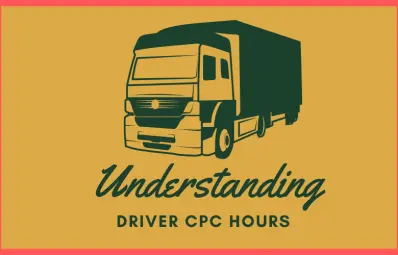Understanding Driver CPC Hours: A Comprehensive Guide for HGV Drivers
Welcome to the world of professional driving! Whether you’re just starting your journey as a Heavy Goods Vehicle (HGV) driver or you’re a seasoned road veteran, understanding your Driver Certificate of Professional Competence (CPC) hours is not just a regulatory requirement—it’s a stepping stone towards a safer and more proficient driving career. Today, we’re diving deep into the essentials of CPC hours: how to check them, calculate your needs, and comply with the regulations, all while keeping you engaged and steering towards enhancing your skills with GS Driver Training.
Why Understanding CPC is Essential for Your Business Success
The Driver CPC is a standard introduced across the European Union to maintain high driving standards and improve road safety. For professional bus, coach, and lorry drivers, completing 35 hours of periodic training every five years is not just a legal tick box; it’s an opportunity to refresh your skills, learn new ones, and ensure you’re up to date with the latest in road safety, fuel efficiency, and legislative changes.
Checking Your CPC Hours
Wondering how close you are to meeting your training requirements? For UK drivers, this is easily accessible through the [Gov.UK website](https://www.gov.uk/check-your-driver-cpc-periodic-training-hours), where with just your driving licence number, you can view your completed hours and plan ahead. It’s a straightforward process designed to keep you informed and prepared.
Calculating Your CPC Hours
Every five years might seem like a long interval, but time flies faster than a lorry on a motorway!
Understand the 35-hour Requirement
Break down the 35 hours into seven-hour sessions to make your training manageable and meaningful.
Keep Personal Records
Besides the official channels, maintain your own log of training sessions—this helps in planning and provides a backup in case of discrepancies.
Spread It Out
Instead of cramming all your training into the final year, spread it throughout the five-year period. This keeps your knowledge fresh and reduces the stress of last-minute compliance.
Complying with CPC Hours: Make It Count
Compliance doesn’t have to be a chore. At GS Driver Training, we believe in making every hour of your CPC training count towards making you a better driver. Here’s how:
Select Courses That Matter
With a wide range of CPC courses available, choose those that enhance your skills and knowledge. Whether it’s eco-driving techniques or advanced safety protocols, make each hour contribute to your professional growth.
Plan and Prepare with GS Driver Training
Why Choose GS Driver Training for Your CPC Hours?
At GS Driver Training, we’re more than a training provider; we’re your career development partner. Here’s why you should book your next CPC course with us:
Expert Instructors
Our team comprises experienced professionals who are not just trainers but industry veterans with real-world insights.
Flexible Schedules
We understand the life of a professional driver. Our training courses are designed to fit around your commitments.
Engaging Content
Say goodbye to dull lectures. Our courses are interactive, practical, and relevant to your daily driving experience.
What is CPC Periodic Training
CPC Periodic Training is an essential aspect of the Driver Certificate of Professional Competence (CPC) required for professional bus, coach, and lorry drivers within the European Union and the United Kingdom. This training is designed to ensure that drivers of heavy goods vehicles (HGVs) and passenger carrying vehicles (PCVs) maintain high standards of driving and professional competence throughout their careers. Here are the key elements of CPC Periodic Training:
Objective
The main goal of CPC Periodic Training is to enhance road safety and improve the professional skills of drivers. It focuses on:
Updating the drivers’ knowledge, ensuring they stay informed about the latest road safety regulations, driving standards, and industry practices.
Promoting fuel-efficient driving techniques.
Emphasising the importance of health and safety for both the driver and other road users.
Requirements
To comply with CPC requirements, drivers must:
Complete 35 hours of Periodic Training every 5 years to maintain their Driver CPC qualification.
Undertake training in approved centers, with courses that are relevant to their work and contribute to their professional development.
Driver CPC Training
1.The training covers a wide range of topics, including but not limited to:
2.Legal requirements and regulations for HGV and PCV drivers.
3.Health and safety, including first aid and emergency procedures.
4.Safe and fuel-efficient driving (eco-driving techniques).
5.Customer service and professional development.
6.Use of tachographs and compliance with working time regulations.
Format
Periodic Training is delivered in modules, typically:
Each training session lasts for at least 7 hours (excluding breaks).
The 35 hours can be broken down into five 7-hour days of training over the 5-year period.
There is no pass or fail element to the training; attendance and participation are the key components.
Record Keeping and Verification
Upon completion of training hours, records are updated on the national database by the training provider. Drivers can check their completed CPC training hours online through the respective governmental websites (e.g., DVSA in the UK) to ensure they are on track with their training requirements.
Importance
CPC Periodic Training is critical not only for legal compliance but also for the personal and professional development of drivers. It ensures that drivers are well-equipped with the latest knowledge and skills needed to navigate the roads safely and efficiently, thereby contributing to the overall safety of road transport and minimizing environmental impact through eco-friendly driving practices.
Overall, CPC Periodic Training is a continuous investment in the competence of professional drivers, enhancing their abilities, ensuring safety, and promoting a more environmentally sustainable transport industry.
Take the Next Step
Understanding and complying with your CPC hours is a significant aspect of your driving career. It ensures you remain at the top of your game, legally compliant, and professionally ahead. Contact GS Driver Training today to book your CPC course. Let us help you navigate the road ahead with confidence, skill, and compliance.
Remember, your journey towards being a safer, more efficient HGV driver doesn’t end with CPC compliance—it begins there. Join us at GS Driver Training, where we don’t just check boxes; we open roads to new possibilities.
Contact GS Driver Training now and gear up for a journey where every mile and every hour counts towards your success on the road.
Driver CPC FAQs
Understanding CPC Hours: How to Check, Calculate, and Comply
Q: How do I check my completed CPC hours?
A: Drivers can check their completed CPC hours through their national online database provided by the Driver and Vehicle Standards Agency (DVSA) in the UK or equivalent bodies in other countries.
Q: How are CPC hours calculated, and how do I ensure compliance?
A: CPC hours are calculated based on attendance in approved CPC training courses. Why 35 Hours of Periodic Training After Every 5 Years. Planning your training sessions well in advance and spreading them out across the 5-year period helps ensure compliance.\
Driver CPC Card and Training
Q: What is a Driver CPC card, and when will I receive it?
A: The Driver CPC card, also known as the Driver Qualification Card (DQC), is proof that you have met your CPC requirements. You’ll receive it after completing the initial qualification or the 35 hours of periodic training.
CPC Training Course and HGV Training
Q: How do I choose the right CPC training course?
A: Choose a course that is relevant to your work and contributes to your professional development. Training centres often offer advice on course suitability based on your role and experience.
Q: How are CPC hours calculated, and how do I ensure compliance?
A: CPC hours are calculated based on attendance in approved CPC training courses. Why 35 Hours of Periodic Training After Every 5 Years. Planning your training sessions well in advance and spreading them out across the 5-year period helps ensure compliance.
Driver CPC Card and Training
Q: What is a Driver CPC card, and when will I receive it?
A: The Driver CPC card, also known as the Driver Qualification Card (DQC), is proof that you have met your CPC requirements. You’ll receive it after completing the initial qualification or the 35 hours of periodic training.
CPC Training Course and HGV Training
Q: How do I choose the right CPC training course?
A: Choose a course that is relevant to your work and contributes to your professional development. Training centres often offer advice on course suitability based on your role and experience.
Q: What’s the difference between HGV training and Driver CPC?
A: HGV training is focused on acquiring the skills to drive heavy goods vehicles safely, leading to a licence in a specific category. Driver CPC is about ongoing professional development and safety for licensed drivers.
Training Centre and Course Suitability
Q: How do I find a quality training provider?
A: Look for training centres accredited by the Joint Approvals Unit for Periodic Training (JAUPT) or equivalent, ensuring they meet national compliance training standards.
Periodic Training Courses and Compliance
Q: How many Driver CPC periodic training courses must I take?
A: You must complete a total of 35 hours of periodic training every 5 years, which can be divided into sessions (usually 7 hours each).
Q: What topics are covered in relevant training modules?
A: Modules cover a range of topics including legal compliance, health and safety, eco-driving techniques, and customer service, tailored to the needs of professional lorry drivers.
Costs, Requirements, and Upcoming Courses
Q: What is the typical training cost for Driver CPC?
A: Costs vary by training centre and course content. Contact quality training providers for detailed information on pricing and any available funding.
Q: What are the key driver CPC requirements?
A: Drivers must hold a valid driver licence for the vehicle type, complete 35 hours of periodic training every 5 years, and carry their Driver CPC card while driving professionally.
Q: How can I find out about upcoming courses?
A: Training centres and quality training providers often list upcoming courses on their websites. You can also contact them directly for schedules and availability.
Licences, Standards, and Regulations
Q: What’s the importance of the operator licence in relation to Driver CPC?
A: The operator licence is required for businesses operating HGVs or PCVs. Compliance with Driver CPC is part of maintaining standards for operator licensing.
Q: How do Driver CPC and drivers’ hours regulations relate?
A: Both are designed to improve road safety and working conditions in the road transport sector. Adhering to drivers’ hours regulations is part of the training content for Driver CPC.
Q: How many hours can HGV drivers legally drive in a day?
A: HGV drivers can legally drive up to 9 hours in a day. Duration could be Extends from 10 hours to Twice a Week.
Q: What are the break requirements for HGV drivers under EU regulations?
A: HGV drivers must take a 45-minute break after every 4.5 hours of driving. This break can be split into two periods: the first being at least 15 minutes and the second being at least 30 minutes.
Q: What is the purpose of the Driver CPC course for HGV drivers?
A: The Driver CPC course aims to enhance road safety and professional driving standards across the EU. It mandates 35 hours of periodic training every 5 years to keep HGV drivers updated on safety practices, legal regulations, and efficient driving techniques.
Q: Is the Driver CPC ongoing training required for all HGV drivers?
A: Yes, all professional bus, coach, and lorry drivers need to complete 35 hours of periodic training every 5 years to maintain their Driver CPC and legally drive professionally.
Q: How do road transport regulations affect HGV driving?
A: Road transport regulations ensure the safety of the vehicle, driver, and cargo. They govern vehicle standards, emissions, drivers’ working hours, and secure cargo loading, aiming to improve road safety and reduce environmental impact.
Q: What are the consequences of non-compliance with road transport regulations?
A: Non-compliance can result in fines, legal action, loss of licence, or impoundment of vehicles, significantly affecting operational capabilities and company reputation.
Q: What is a fast track HGV class, and who should consider it?
A: Fast track HGV classes are intensive training courses designed to quickly prepare individuals for their HGV tests and licensure, suitable for those looking to enter the HGV driving profession promptly.
Also Read
How to get your CPC card







